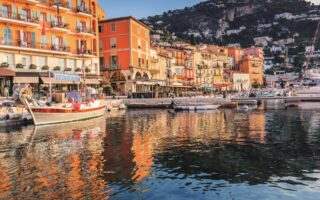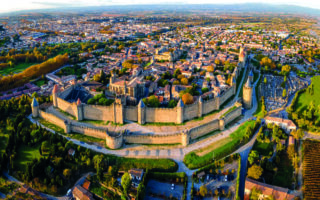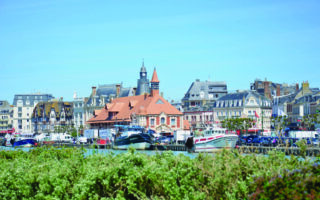Tarn – A Hidden Treasure In South West France

Advantages of Owning A Property In The Tarn
Is the Tarn the hidden treasure of the south-west France? Phil Frogham, from agency Abitasud in Realmont, explores why the department might appeal to house-hunters.
The Department of the Tarn (81) has everything, either within its own boundaries or nearby. Discover below the many advantages of owning a property in the Tarn in south west France.
Location, Location , Location
Situated slap bang in the middle of the south west of France, the Tarn offers everything, either within its own boundaries, or close by.
The Tarn is close to the Mediterranean coast at Beziers, Narbonne and Perpignan, and not too far from the Atlantic coast at Biarritz. So day trips to the seaside are possible. In winter, skiers can leave the Tarn for the Pyrenees in the morning, have a full day on the piste, and be home in time for an “apero” and dinner. If your interest is shopping, a visit to Andorra, with its wide selection of top brand, duty-free consumer goods, is also possible in a single day. And if you fancy a change of country, the Spanish border is within easy reach, just the other side of Perpignan.
Advantages
The Tarn offers a most agreeable climate, breathtaking scenery, a rich heritage of culture and history, plus everything for an active or a peaceful weekend, holiday, or life. For a real taste of the Tarn, the world-famous Gaillac wine region and some of the best gastronomic delights in France are right on your doorstep. For the property buyer, the Tarn offers some of the most reasonable prices in the south of France, from a weekend ‘village house’ (needing some decorative work) at € 85,000, to your very own chateau for € 730,000.
Transport
- Air Travel
Close to Toulouse Blagnac Airport to the west, Carcassonne Airport to the south, and Rodez Airport to the north east, the Tarn is easily accessible from the UK and Ireland by air via Ryanair, easyJet, BMI, FLYBE and British Airways. Internally, Castres-Mazamet airport in the south of the Tarn offers regular links to Paris Orly and Lyon. The Tarn is also within reasonable distance of Biarritz, Pau, Girona, Perpignan and Montpellier airports.
- By road:
Motorway links are excellent – for Paris and the north of France (A20 and A75), Bordeaux and the west (A62 and A10), northern Spain (A64), and the Mediterranean coast and southern Spain (A61 and A9).
- By rail:
High speed TGV rail links to all parts of France and Spain are available through nearby Toulouse and Montauban, where you can get local rail connections to the main towns in the Tarn.
Main Towns
- Albi
Albi is the prefecture and main city of the Tarn. The city’s attractions are by no means limited to the Cathedral of Saint Cecilia and the Toulouse-Lautrec Museum. Visitors can also enjoy the charm of its old quarter, the lovely setting of the River Tarn flowing past the Palais de la Berbie, the city’s gardens and parks, and the Romanesque art and Renaissance architecture.
- Castres
Built along the banks of the Agout river, Castres, sub-prefecture of the Tarn, is a town of 47,000 inhabitants. One of the original stopping places on the pilgrimage path to Saint James of Compostella, the town rapidly expanded in the 9th century. It now houses the famous Goya Museum, and is the gateway to the nearby Parc Naturel Regional du Haut-Languedoc, the Sidobre, with its natural landscapes dominated by the rough, monumental shapes of granite blocks, the Monts de Lacaune and the Montagne Noire.
- Gaillac, Cordes-sur-Ciel, Lautrec
Gaillac, to the north, is the centre of the world-famous Appellation Gaillac vineyards, and is well situated for the Bastides of the Tarn – medieval, walled villages such as Cordes sur Ciel and Lautrec, which are to be found throughout the Department.
Climate
The Tarn has a unique topography (mountains, valleys and plains), and the climate of the Tarn is relatively mild in the winter. Cold at night, daytime temperatures of up to +12 degrees Celsius are common (although, in January 2007, temperatures of +20 degrees C have been recorded in and around Castres). Summer months boast a warm +30 degrees C. Blue skies and sunshine abound for most of the year. Another advantage is that springtime tends to start one month earlier, with the autumn period ending one month later, than the UK and Ireland, so outdoor activities are possible from the beginning of March right through October and into November.
Breathtaking Scenery
There is a wide variety of breathtaking scenery in the Tarn. Rivers, lakes, forests and valleys are found throughout the Department.
The three main rivers are the Tarn, travelling east to west through Albi and the Gaillac wine region in the north, the Dadou, which cuts through the centre of the region through Realmont and Graulhet, and, in the south, the Agout, which flows through Brassac, Castres and Lavaur. Smaller rivers and mountain streams abound everywhere, especially in the mountainous Monts de Lacaune and Montagne Noire in the south east and south respectively, both of which resemble the Highlands of Scotland, with peaks of well over 1000 metres (3,000 feet). These two areas also contain the main lakes of the Department – the Lac du Laouzas and the Lac de la Raviege in the Monts de Lacaune, and the Lac des Sts. Peyres, Lac des Montagnes, Lac du Cammazes, Lac du Lampy, and the Lac de St. Ferreol in the Montagne Noire.
The Tarn is also a region of forests. The Foret Departementale de Serenac, near Albi, has 200 hectares (494 acres) of conifers and oaks, footpaths and picnic areas. The Foret Departementale de Sivens in the north-west offers 600 hectares (1,482 acres) of woodland, themed exhibitions, guided tours on the theme of the environment, footpaths and forest nature paths. In the south east, the Forets Domaniale et Communale de Lacaune contain 1,350 hectares (3,335 acres) of broad-leaved trees and conifers, rocks and peat bogs, numerous footpaths, le Montalet exploration path, the Calmels arboretum, and picnic areas with facilities. And in the south, the Forets Domaniale et Communale de la Montagne Noire encompass 31,600 hectares (78,052 acres) of oaks, chestnuts and spruce, picnic areas, lakes and activity trails.
History and Culture
The Tarn possesses a rich heritage of old, fortified villages, castles, churches and museums.
For example, in Albi, the Cathedral of Saint Cecilia is a masterpiece of Southern Gothic art (13th – 16th century), whilst the Toulouse-Lautrec Museum, in a former archbishop’s palace built in the 13th century, houses over 1000 works by the Albi-born artist. The museum includes drawings, lithographs and all 31 of the world-famous posters he designed.
Castres is home to the famous Goya Museum, containing works by the renowned Spanish Master, and the Jean Jaures National Centre and Museum, which retraces the life of this great orator, born in Castres in 1859.
Gaillac offers the Museum of the Abbey, the Vine and Wine – collections devoted to archaeology, the river traffic of the Tarn and the history of wine-making in the region.
In Labruguiere in the south of the Department, the Espace Photographique Arthur Batut presents the photographic apparatus conceived and perfected by the inventor of aerial photography.
The list is endless.
Activities and Sports
For the active person, the Tarn is a department of sports and leisure activities.
- Rugby
Rugby is a major sport, with Sporting Club Albigeois and Castres Olympique competing in the French Top 14 and European Championships, and UA Gaillac playing in the Pro D2 second division.
- Water Sports
Water sports abound on the many natural and artificial lakes, rivers and natural watercourses of the Tarn. Examples are the Espace Nautique Atlantis in Albi (indoor and outdoor pools, water slides), Lac de la Raviege in Angles (beach, motorised water sports, water-skiing, sailing, fishing), l’Archipel in Castres (a 5 hectare complex with competition pool, fun pools, spa, fast-current rivers, slides), the Espaces des Sources Chaudes in Lacaune les Bains (with pools, river etc), and the Lac de Saint-Ferreol in Soreze (swimming in the lake, water sports, pedal boats, tennis etc). Canoeing and sailing are available on the Aveyron, Agout, Cerou, Viaur and Tarn rivers, as well as the various lakes mentioned above.
If you like fishing, there are numerous opportunities for coarse and river/lake fishing throughout the region.
- Golf
For golfers, there are courses at the Golf d’Albi-Lasbordes in Albi, Golf de Castres-Gourjade in Castres, Golf des Etangs in Fiac, Golf de Florentin-Gaillac in Florentin, Golf Club de Mazamet-La Barouge in Pont de l’Arn, and the Centre d’Entrainement d’Aigueleze in Rivieres.
Quad bikes are available at the Circuit de l’Aubepine in Puylaurens, the Quad Club in St. Antonin de Lacalm and JMB Quad in Venes, near Castres.
Great Outdoors
For lovers of the great outdoors, there are fifty recommended walks and rambles detailed in the guide Le Tarn a Pied, (published by the Federation Francaise de Randonnees Pedestres and available from local Offices de Tourisme), seventeen ‘Circuits’ by bicycle and seven ‘Circuits’ by car, all devised by the Conseil General du Tarn, including the Sidobre, the Bastides, the Vineyards, the Segala, the Pays de Cocagne, the Montagne Noire and the Monts de Lacaune, each designed to give an interesting, unique and colourful experience of the Tarn.
Horse-riding and trekking are widely available throughout the area (e.g., Les Ecuries de la Sabatarie in Brassac, the Centre Touristique Equestre de Bel Air in Damiatte, le Mas de Biege in Le Margnes, La Jalondie in Montredon-Labessonnie, the Ferme du Lac in Montroc, Les Ecuries du Lac in Nages, the Ferme Equestre de la Gresigne in Saint-Beauzile and the Ferme du Rock in Puycelsi).
Gastronomie
The Tarn is famous for its variety of culinary delights. Produce is varied and of the highest quality, with local specialities including cheeses, lamb, pork, rainbow trout, duck, geese and other poultry, confit, foie gras, venison, cured hand-made sausages, terrines and pates, honey – the list goes on.
Most local produce is available through supermarkets, but it is much more fun to visit and buy from the many specialist shops (boucheries, charcuteries etc), direct from local farms, or to shop at the local markets, which take place on a regular basis in almost every town and village throughout the region, and where you can usually taste before you buy.
As in all parts of the south west of France, eating out in the Tarn is taken very seriously. Many restaurants offer delicious plats du jour from just € 6, or you can spend upwards of €75 per person on a multi-course, gastronomic experience in award-winning establishments. The choice is wide and varied, the food always excellent and good value.
A new development is the Ferme Auberge (Farm Inn), where traditional meals are served with or without accommodation. For example, Les Chenes in Larroque offers roast piglet, leg of lamb, venison stew, stuffed roast duckling and home-made coq-au-vin. The Combe Ramond’s specialities in Maurens Scopont include chevreau grille (roast kid), mitonnee d’agneau (lamb), pigeonnaux farcis (pigeon) and terrine de lapin (rabbit pate).
To accompany your meal, the world-famous Gaillac wine region in the Tarn offers a multitude of reds, whites and roses. The Commission Interprofessionnelle des Vins de Gaillac in Gaillac is open all the year round, where you can obtain advice on the whole range of Gaillac wines – and taste them of course. In fact, most Chateaux, Domaines and Mas wine producers in the region offer visits, tastings and sale of their products direct to the public.
Property in the Tarn
Prices in the property market in the Tarn have been relatively stable. However, property prices in the north of the Department have generally been about 15% higher than in the centre and south of the Tarn, due to the recently opened A68 autoroute. This motorway has brought with it many people, who work in Toulouse, but who want to live in a more rural area, thus leading to more demand in the northern area. Gaillac and Lisle sur Tarn are two towns, which have shown growth as a result of this move out of the city.
According to trade sources, the future of the property market in the Tarn should continue to be stable over the next few years, although the axis between Toulouse and Castres in the south could undergo a fairly large price increase (up to 20%) in the future, due to a new autoroute planned to link these towns. However, the Tarn continues to offer good value for money in terms of property prices, especially compared to neighbouring departments and other regions in France.
As you would expect, there is a wide range of properties available in the Tarn, from medieval chateaux, for those who would like to live in splendour, through detached villas with their own swimming pools, to smaller village houses, ideal for weekend or holiday visits.
© Article written by Phil Forgham
Share to: Facebook Twitter LinkedIn Email
More in activity, aveyron, courses, estate agents, guides, summer, travel
By David Bolton
Leave a reply
Your email address will not be published. Required fields are marked *




REPLY